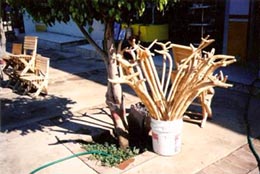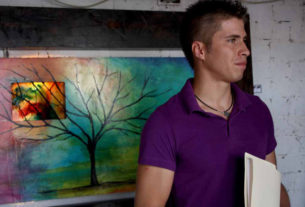At Home in Talpa de Allende, Jalisco
They are called romerías or peregrinaciones, and the people who make them are usually called peregrinos. They are pilgrims coming to pay homage to Our Lady of the Rosary of Talpa, and they come by the thousands at this time of the year.
March 19th is celebrated as St. Joseph’s Day, and as you may know, all these religious holidays are celebrated by nine days of mini-celebrations prior to the main day.
In the case of Talpa, this particular celebration begins on the first Sunday in March when the pilgrims from Tecoman, Colima walk in. Tecoman is roughly two hundred seventy highway miles from Talpa. People come in chartered buses, private automobiles, on horse-back and bikes, but the healthiest, and the most faithful come walking.
The walkers don’t necessarily stick to the highways. Some follow the river up from the coast, and sleep on ranchers’ verandas. A good walker can make it in three days from Puerto Vallarta, spending only two nights in the open. If a family with children makes the walk, count on three nights on ranches.
Back packs are filled with the minimum of items. Matches for building a fire, and warm blankets to huddle under are a must in March. Many folks pack their pockets with raisins and nuts to snack on for that extra boost of energy. Each walker has his own canteen. There are no hotels or restaurants along the river route, but many enterprising ranchers use this opportunity to make the extra peso or two. One can usually buy a hot bowl of soup before resting for the night and a hot cup of coffee, tortillas and beans send him off the next morning. For an extra peso, he can re-fill his canteen, if needed.
This is not an easy stroll in the countryside. Mountains, huge boulders, rivers, sharp rocks, unfriendly dogs and bulls are a few of the obstacles one has to circumvent.
You must choose your walking shoes very carefully and preferably, several months before starting out on this trek in order to “break them in.” It is best to buy shoes one size too big, and fill them up with extra socks when you start. Those walking feet will grow. Many of our walkers show up in the plaza with their shoes hanging around their necks.
The March Walk has become such a tradition that some local families will take the bus a few miles out of town, and walk back, in order to introduce their children to this ritual. Many fathers take their young sons further down the road to walk back, spending the night in the countryside.
These celebrations often seem more like a street fair than a religious festival. Booths are set up in late February, displaying everything from charcoal burners made from tin to sun lotion. Wide-brimmed hats and warm blankets are popular items.
Dancers dressed in ancient Indian garb dance down the streets to perform rituals in the plaza. Booming fireworks awaken you early in the morning for the first mass of the day. I’ve heard new-comers complain of this tradition, but look at the meaning of tradition. Locals claim the fireworks “scare the devils away.” One thing is for sure. They can scare the devil out of me at 5 o’clock in the morning.

It is a gala time for one and all. Restaurants are packed elbow to elbow, and open cooking fires line the river banks where many families prepare their meals.
T-shirts and walking sticks are hot items. I never thought I would see the day when images of The Virgin were printed on clothing, but it is there in the shops. Some shirts simply say, “I Walked to Talpa,” others have maps of roads leading to Talpa printed on them.
Most folks buy a Talpa Walking Stick before they leave here. It is almost like a badge that they have made the pilgrimage. Why these sticks are called Talpa Walking Sticks, I don’t know because I’ve seen them in other parts of Mexico. They are made from a stick of bamboo. The root end is trimmed to form a three-pronged handle, which fits the hand very comfortably. If the bamboo is cut young, the handle fits a young child’s hand; left to grow, it will fit a big man’s hand. Some people call them burros, and I guess if you have an active imagination, you could see that they resemble a donkey.
Don Julio Alvarez has been making the walk from Tecoman for the past thirty-two years. He declares he used to walk it in six days when he was a younger man. Now he leaves Tecoman mid-February in order to be in Talpa by March 19.
Over the years, Don Julio has made friends on ranches and in pueblos, and he stops for a few days rest in each place. He probably could have his chauffeured limousine bring him to Talpa, but he walks.
His sleeping pad is a protected corner on the back stoop of two old-maid sisters’ house in Talpa. There he sleeps with Monica, the cat and Tizoc, the dog curled by his side to keep him warm.
The oldest spinster is the self-appointed cook in this house. She’s the first one up in the morning to put the coffee on the fire to perk and re-heat the beans from yesterday’s lunch, which she shares with Don Julio at her kitchen table.
I can hear her from my front window calling out, “Dame un beso, Periquito, dame un beso!” “Give me a kiss, Little Bird, give me a kiss.” She’s talking to her parakeet, not Don Julio.
The day will, inevitably, come when Don Julio can’t make the walk. Tizoc, Monica, Periquito, and the two spinsters will be gone, but the Walk to Talpa tradition will go on.

